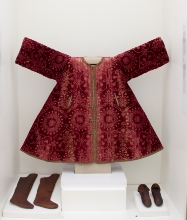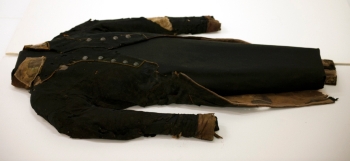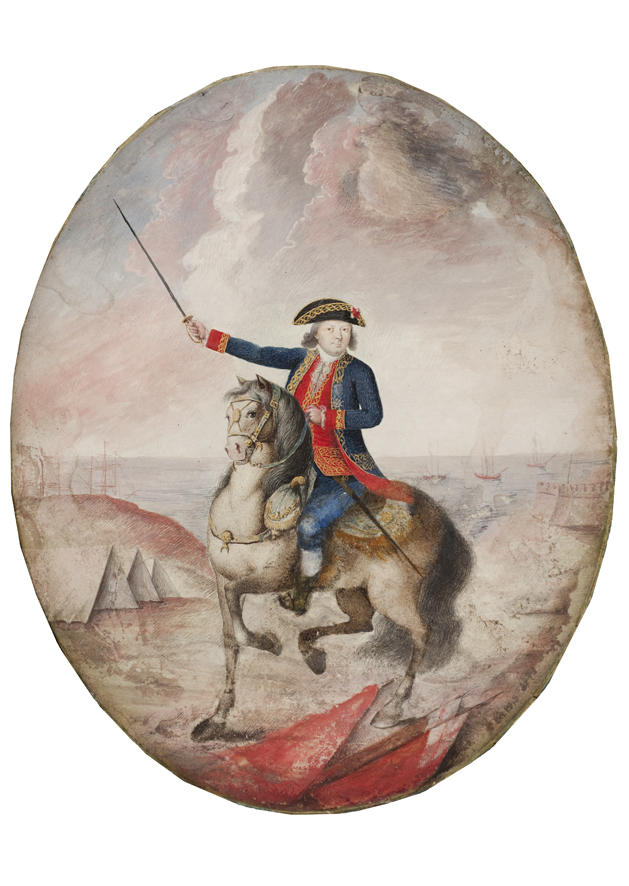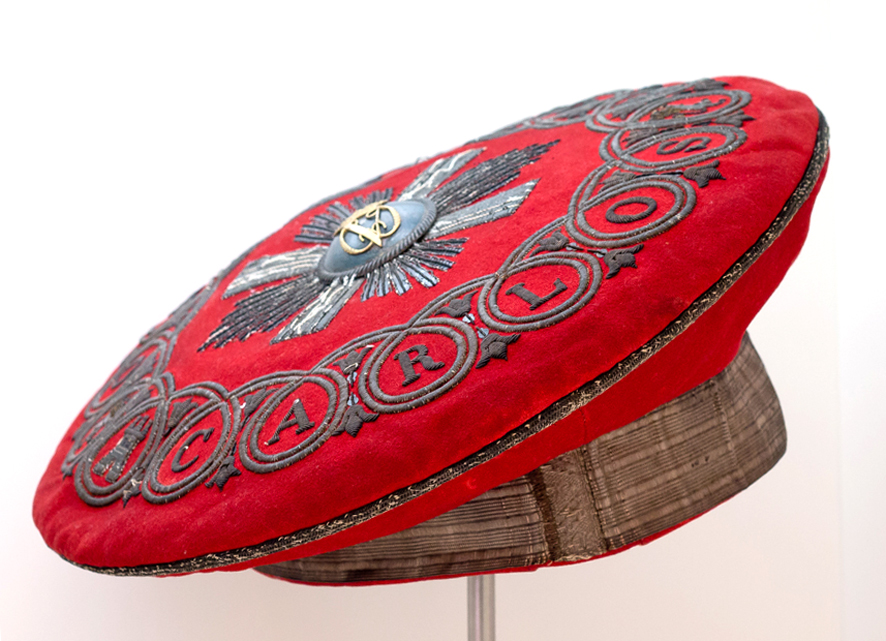HISTORICAL TOUR

The halls of the Historical Discourse located in the Alcazar Building (shown in the map as H1, CI and H2 are arranged chronologically, and all of them are structured around five tours which are indicated by the following icons. These refer to the general topic covered by each of the routes.
Spain and its Military History
The Military Organization and its Men
The Material Resources
The Art of War
Army and Society
If you are interested in a complete tour, we kindly recommend to visit these halls following the chronological order, starting at the Spanish Monarchy and ending at the 20th century.
If you are interested in any specific topic, we kindly suggest you organize your visit following the same route in each hall. For instance, if you are interested in the armament used in each of the historical periods, you can visit the tour called “The Material Resources”, focused on showing what these resources were and how they evolved in each era.

The Hall known as “the armies before the Army” (N3) shows pieces related to the emergence of war societies and the setting up of the first armies, from the primitive prehistoric weapons, through the Roman legions and the medieval hosts.

The discovery of America and the end of the reign of the Catholic Monarchs are the events that mark the beginning of the visit to this first hall of the historical discourse. The set of pieces that belonged to Boabdil el Chico (Muhammad XII of Granada), Marlota and Jineta, are the protagonists of this first space, which is completed with the portraits of the kings from the Habsburg dynasty.
In the 16th and 17th century, the Tercios are the base of the Habsburgs’ army. Their organization, their apparel, their weapons are represented in the hall through a selection of items which include documents like artillery treaties, pennants, scenes depicting the Tercios’ troops, swords, harquebuses and muskets or artillery pieces, such as the bombard from the 16th century which presides the center of the expository space devoted to the material resources.
Large format painting, sculpture, carvings, ivory-carving art tell us about some facts and historical personages which had a relevant role at the time. The painting “The Death of Pizarro” or “Queen Isabella I of Castile Visiting Toro’s Hospital”, Garcilaso de la Vega’s olifant or the recreation of the three-key ark, together with manipulative objects and dioramas, complete the tour of this hall.

The Bourbon dynasty sits on the Spanish throne in the 18th century. The historical protagonists of this moment are present in the hall through portraits, coats of arms, sculptures of the monarchs Philip V, Ferdinand VI, Charles III, Charles IV.
It is time to create a Permanent Royal Army standardized by ordinances and regulations. The Corps of Infantry and Cavalry are restructured; Artillery and Engineers Corps are organized. In America, the army is based on a system of militias integrated by all social sectors.
The Enlightenment boosts the development of the Academies, where the Army also has a relevant role, to put into practice scientific instruments and mathematical approaches in which the Vauban system of fortification is based, a model that spreads over Europe and America. There are progresses in the offensive and defensive systems, new types of firearms are developed and cold weapons become standard-issue. All these events are articulated within the hall’s discourse through the exhibition of different items related to them.
The diorama of the Battle of Almansa falls into the context of the War of the Spanish Succession. From the Seven Years’ War, the expeditions on northern Africa and the Spanish participation in the American Revolutionary War are exhibited pieces like the flag of Pensacola or the items related to important personages such as Bernardo de Gálvez.
There is a large number of contributions to the civilians made by the military over this century, both within the political realm, the scientific knowledge and the very dissemination of culture. The building of public infrastructure by military engineers at this time is vital. It must be highlighted the creation of the current national anthem and the red-yellow flag, that will become permanent in 1843.

The tour of this hall starts with the introduction of the relevant historical personages from this period. The portraits, in different formats, of Charles IV, Ferdinand VII, Isabella II and Maria Christina, are accompanied by those of Godoy, José Bonaparte, Diego de León or Espoz y Mina, just to mention some of the most important ones.
The French Revolution and the Spanish War of Independence mark the period. The Battle of Bailén, first Spanish victory in this war (1808-1814), is presented through an audiovisual which shows the military strategy developed at that clash. The portrait of Manuela Malasaña, Daoíz’s Jacket or the sculpture of Lieutenant Ruiz evoke the resistance of Madrid against the French on May 2nd, 1808.
The Cádiz Cortes of 1812 create the National Militia, turning the Royal Army into the National Army, changing the concept of service to the king by that of service to the nation, appearing for the first time the professional soldier and the Army decorations system. To illustrate these facts, in the hall are exhibited military uniforms, portraits and decorations from the Royal Order of Saint Ferdinand, among others.
The tour through the different showcases narrates the derogation of the Constitution of 1812, the return of Ferdinand VII, and the military uprisings lead to the Liberal Triennium. The emancipation movements in America add to this. The nomination of Isabella II as heir to the throne of Spain, under the regency of Maria Christina of Bourbon, will lead, in 1833, to the first Carlist War, which will end with the Hug of Vergara, in 1839, endorsed by General Espartero.
With regard to scientific progresses, it is worth mentioning the appearance of the optical telegraphy, the mountain artillery and a new system for casting cannons.

The coronation of Queen Elizabeth II in 1843, opens up a very tumultuous period in Spanish history. The partisans of Carlos María Isidro of Bourbon, the Queen’s uncle (conservative and absolutist in ideology), and those of Elizabeth’s (liberals) will soon clash in the Carlist Wars.
During Elizabeth’s reign, prestigious military officers- known as “los espadones” (the big swords)- held the reins of the successive governments, no matter their conservative, moderate or progressive leaning. The hall displays high artistic value portraits of Elizabeth II and of generals like Narváez, Espartero or O’Donnell. Military uprisings became recurrent; a consequence of the economic and political crisis the country was living through. Some of General Prim’s personal objects, the berlin coupe in which he was assassinated, portraits of Amadeo I- king of Spain between 1871 and 1873-, the proclamation of the First Republic or Alfonso XII and his ascent to the throne, are all represented in this hall by dint of different pieces belonging to the major figures of that moment.
The nineteenth century brings along the substitution of the Royal Army for an Army with a national character, the advent of a new Ministry of War and the reorganization of the different armed branches and corps, as well as the creation of new ones like the Guardia Civil Corps, founded in 1844.
Armed conflicts rage in various theaters. In Spain, the Army has to cope with the Carlist Wars; the conflict for independence breaks out in Cuba; and, at the same time, Spain takes part in expeditions to Cochinchina, Mexico and some African countries.
The flags are unified and in 1843 the red and yellow flag and the “marcha de granaderos” (“grenadiers’ march”, the old national anthem) are used for the first time as national emblems. The Order of Military Merit is created and new corps come into being, like the Guardia Civil in 1844.
New developments, like rifled-bore weapons or firing caps, make their appearance. Within the scientific sphere, military physicians like Santiago Ramón y Cajal or Fernando Wayler make advancements in the prevention and treatment of infectious diseases. The military play also an indisputable role in the layout of the railroad network and the enhancement of communications in the peninsula.

The arrival of Alfonso XII in 1874 marks the end of the Carlist Wars. The Constitution of 1876 grants the supreme command of the Armed Forces to the Crown, hence the meaning of the image of a king-soldier who will often wear his uniform, as it can be seen in portraits and sculptures in the hall, both of Alfonso XII and Alfonso XIII.
In 1898 takes place the loss of the Overseas territories: Cuba, Puerto Rico, the Philippines and the Pacific archipelagos. These facts are represented in the hall through the scenography and exhibition of items linked to historical personages and events related to them.
In that period, Spain will claim to be neutral during World War I, will go through General Primo de Rivera’s coup in 1923 and the creation of the Legion (Tercio de extranjeros – Tercio of foreigners) in 1920 by Lieutenant Colonel José Millán Astray, being the guidon of the 11th Bandera of the Legion exhibited as the testimony of such birth.
The Spanish Army is a model of the scientific and technical progress of our country, as it can be seen through its participation in the World Fairs of Paris, Barcelona or Chicago in 1893. Among other items, three commemorative medals bear witness to this presence.
At this time, the use of electricity in the factories increases the production of artillery pieces and armament. The rifle Mauser, model of 1893, is established as standard-issue, serving as a sample the one that belonged to Corporal Noval. 12 and 21cm artillery pieces also become standard-issue, like the 7cm Schneider gun.
In terms of social work within the Army at this time, it is worth mentioning the literacy programs for the troops. In the hall are exhibited reading and writing learning notebooks for enlisted troops. In 1889 is created the Aerostat Unit, which acquired a hot-air balloon whose basket is exhibited at the museum.

The visit to this hall, given over to the recent history of Spain, starts in 1923 with the collapse of the monarchy. The holdings on display reflect the period of political instability that spans the Second Republic and the Civil War, and the subsequent General Franco’s dictatorship which, after nearly forty years, would give way to the current democratic Spain.
Since the twentieth century is the century of motion pictures, several audiovisual presentations show some crucial moments of this period such as the celebration in the streets of the Second Republic proclamation, the departure from Spain of Alfonso XIII, images of the coup known as the “23-F”, or the message that King Juan Carlos I addressed to the Spaniards when the coup had not yet been put down.
All these changes would also reach the Army, who undergoes a series of successive reforms. The military are integrated into a structure of armed branches, corps, scales and specialties in accordance with their missions and the tasks assigned; an organization that is going to be adapted depending on the prevailing circumstances at the time. This is the origin of the Nomadic Groups, the Sea Companies, the Paratroop Brigade or the Mountain Units. Badges and decorations and the way they must be borne on the uniform are also changed.
The twentieth century’s technological developments bring about an improvement of portable weapons, which become lighter and more effective, like the assault rifle. An example of another technological product, the Enigma encrypting machine, can be seen here.
The conflict with Morocco, the Al Hoceima landing in 1925 and the Green March in 1975, are represented here by means of a careful selection of holdings and a diorama depicting the aforementioned operation in Al Hoceima.
No doubt, the Civil War is the most significant episode in Spain’s history during the twentieth century. The main facts of the war, the personages, the organization and assets used, as well as the fronts and battles, are all present in the narrative by means of the exhibition of holdings related to the people that took part in these historic events. There are also pieces related to the División Azul (Blue Division), witnesses to the Spanish presence in World War II.
The visit to this hall comes to an end with the contributions of the military to the fields of science, health and culture.

Lastly, the hall that closes this itinerary trough the military history of Spain is known as “The Army nowadays” (N3). The pieces exhibited in this hall bring us closer to the role played by the Army in the missions abroad as well as to the work performed by the different military units in national territory. In order to achieve this purpose and to raise awareness of the work done by these units, the exhibition changes periodically to accommodate all and each of them. (This hall is currently in a pending process of redesigning)



